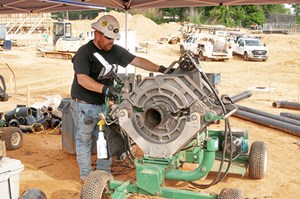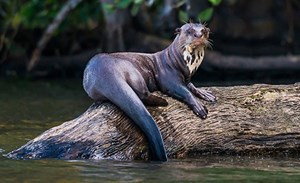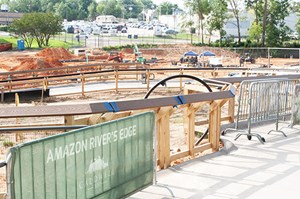December 2023 Vol. 78 No.11
Features
Zoo requires unique, specialized approach to infrastructure construction of new exhibit
By Larissa Copeland
(UI) — When your company specializes in zoo and aquarium exhibits, jobs can get a little bit wild.

But it’s all in a day’s work for Beau Dempsey, owner of Longhorn Organics. Since 2009, the Terrell, Texas, (east of Dallas) company has provided biological design and filtration systems for zoos and aquariums across the United States.
Summer 2023 was no different. Dempsey and his crews were hard at work in Tyler, Texas, to install a piping system for Caldwell Zoo’s latest expansion of its South American exhibit, expected to come online mid-2024.
River’s Edge
“Amazon River’s Edge” is the latest addition to the Caldwell Zoo. When it’s fully up and running, it will include multiple animal species that call the Amazon rainforest home, including capybaras, giant anteaters and three-toed sloths. Another section will house primates like the endangered golden-lion tamarind and cotton-top tamarind.
But the “stars” of the exhibit will be jaguars and a family of giant river otters, each with its very own water feature as part of their habitat.
That’s where Longhorn Organics comes in. Its goal is to fuse approximately 7,000 feet of HDPE pipe, primarily in a space about 65,000 feet wide that will make up the water features of the otter and jaguar exhibits.
Since November 2022, Longhorn Organics has worked alongside Caldwell Zoo professionals to design and install a 20,000-gallon tank that will serve as the focal point of the giant otter exhibit. This tank will include ramps and slides designed to let the animals swim and play as they would in the wild. Equally important is a complex filtration system that will ensure the water stays clear enough for visitors to easily see and engage with the animals, even while underwater.
Giant river otters are social, vocal animals that can reach up to 6 feet in length and weigh as much as 71 pounds according to the Amazon Aid Foundation. Also called “lobos de río,” or “river wolves,” giant river otters form family groups and survive primarily by hunting fish and crustaceans.
Though giant river otters have no serious natural predators, other than humans, the species is endangered due to poaching for the pelt trade and habitat degradation. Sadly, giant river otters are considered extinct in Uruguay and likely Argentina.
“When we choose which animals to bring to Caldwell Zoo, there are multiple things we take into consideration,” said Paul Swen, brand manager. “We want a mix of alluring animals, but we also take ongoing conservation efforts into account.”
Small but mighty
Caldwell Zoo sees 300,000 visitors a year – an impressive feat for a zoo located in a city with a population of 100,000 people. Roughly 3,000 animals call Caldwell Zoo home, and zoo officials, along with animal caretakers, spend countless hours ensuring each animal is healthy, safe and happy.
The Amazon River’s Edge exhibit is no different than any other. Years before the project broke ground, zoo leadership began consulting with the zoo’s curators, along with architects who studied the topography of the space where the exhibit would take shape.
“There are many functionality aspects considered during the design, and especially with water features, all of that functionality needs to come together and work seamlessly,” Swen said.

Like Caldwell Zoo, Longhorn Organics accomplishes a lot with a small team. A 20,000-gallon water feature is a huge undertaking, but it pales in comparison to some of the other projects the company has successfully completed, partnering with SeaWorld and the Seattle Aquarium to produce habitats that measure millions of gallons.
Dempsey’s roots in the world of aquariums run deep. He spent time as the curator of a public aquarium, and through his connections he’s also added an aquatic veterinarian to his team.
“We care a lot about the animals we are designing and building exhibits for,” Dempsey said. “This kind of work is our passion, which is why we do it.”
Laying the Groundwork
For the Amazon River’s Edge exhibit, zoo officials chose high-density polyethylene (HDPE) pipe because of HDPE’s reliability.
“When you install these types of things, it can’t go wrong,” Swen added. “This exhibit will take up about a third of our existing zoo, so it will have a very large footprint. We knew we needed materials that we were confident with, and that we knew would last a lifetime.”
That dependability and durability are also helpful, since the water features are one of the first things installed.
“We need to be able to trust that the pipe can withstand people digging and installing things on top of it, or running over it with machinery,” Dempsey said.
In addition, outdoor exhibits are constantly exposed to the elements. For a water feature like the otters’ exhibit, it’s extremely important to construct piping systems that can withstand summer heat, winter cold and any extreme weather that happens along the way.
Despite the scale of the project, Dempsey said the pipe required for this job is actually on the smaller side. Most are 4-inches, but sizes on this job range from 2 inches to 12 inches. All pipe at Caldwell Zoo is DR 17.
Longhorn Organics started pre-fabricating joints for the zoo when it first mobilized in November 2022. By pre-fabricating, technicians perform some of the more detailed fusion work in a controlled environment, “which gave us a good head start for the installation process.,” added Dempsey.
Away from Longhorn Organics’ fabrication shop, the situation is a little different; onsite, when the weather cooperates, technicians can complete anywhere from 25 to 30 welds a day.
Fusion focused
Even the best-laid plans are no good without quality implementation. At the site, Longhorn Organics is relying on two of its most trusted McElroy machines: a Rolling 618 and a MegaMc 824.
“These machines work great,” Dempsey said. “We have rolling units that we use for pre-fabrication, and we also use a MegaMc 1236 and a TracStar 900.”
Longhorn Organics services each of its fusion machines after 500 welds to ensure their equipment remains in top condition year after year. The company also invests in its people through training, making sure fusion technicians are properly prepared and certified in using the equipment.
Longhorn Organics has well over 100,000 welds under its belt, a point of pride for Dempsey. Fusion technicians are awarded with milestone keychains that announce how many welding projects have been completed, and it’s been turned into a competition.
“When we’re shifting crews around for different jobs, individuals will take their keys and put them in the job trailer. So, when others come onsite, they can see how experienced each person is,” Dempsey said.
That also means anyone who has a question or problem, can identify the most-experienced crew member and know to go to that person.
“It’s a program that works out really well,” he added.
Another layer of security
Longhorn Organics has another quality assurance tool in its belt. McElroy’s DataLogger 7, a ruggedized tablet that records fusion data and uploads it on the Vault, McElroy’s cloud-based storage platform. It archives details of the fusion operation and job site, including operator and machine information, GPS coordinates of each joint, and pressure test results.
“DataLogger 7 lets us see the integrity of each weld that we perform,” Dempsey said. “We’ve never had a weld fail during a pressure test, but having the data in front of us, lets us know for certain that we’re doing everything right.”
In addition, DataLogger records and measures fusion parameters to ensure they’re performed according to the standard being used on the site. This analysis takes place in real time, giving operators the ability to monitor joint integrity during the fusion process.
Dempsey likes to cover all of his bases when it comes to job-site accountability. Only a few companies specialize in filtration installation, and his is the only one that additionally specializes in self-performing HDPE.
That means he’s hand-picked his team and his equipment, and he mobilizes his own staff for installations. That process, he knows, will consistently provide the best results.
“Once you get into this industry, you realize how big it is. There are tons of rescue facilities that need pristine water to contain marine animals, like turtles or dolphins,” he said. “Aquaculture is the same – you don’t want to raise fish in dirty water because those animals are going to be eaten.”
The demand for fabrication and structural HDPE is growing, especially as contractors and engineers continue to realize the financial and logistical benefits of making the switch.
“So many of the environments we work with are corrosive because they involve saltwater. We’re coming up with a lot of commonsense HDPE solutions for water-holding vessels. It’s been a lot of fun, and we’ve got a lot more coming.”
ABOUT THE AUTHOR: Larissa Copeland is the public relations specialist at McElroy Manufacturing in Tulsa, Okla.
FOR MORE INFORMATION:
Longhorn Organics, (469) 689-0999, longhornorganics.com
McElroy Manufacturing, (918) 836-8611, mcelroy.com





Comments